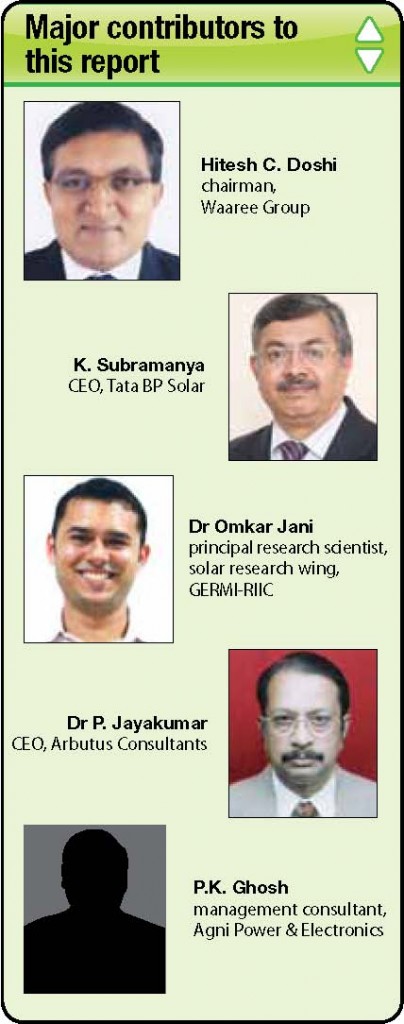“As themegawatt-level solar power plants become more prominent. The employment opportunities of civil, mechanical and electrical engineering would go up considerably. Typically, a one megawatt plant during construction would need a minimum of five engineers in addition to technicians. The government itself has a target through the JNNSM of 1000 MW by 2013 and 20,000 MW by 2022. This offers numerous employment opportunities for engineers. To catch up with this, the manufacturing sector also would need engineers from chemical and mechanical disciplines,” explains Jayakumar.
Subramanya adds, “The job outlook seems extremely positive and enthusing. In fact, the solar industry currently suffers from severe shortage of skills at all levels for rapid growth and particularly in conceptualisation of opportunities, application engineering, marketing, financing, project management, O&M, etc.”
“The two main prospects that I see in this industry are one on the manufacturing side and the other on the power projects side. There are auxiliary areas also such as electronics where things like inverters come into play. Now talking about the manufacturing side, we already do a lot of manufacturing of cells and modules in India but most of the raw materials and equipments are all imported. For example, for the module, most of the equipment and the machinery, solar cells (although solar cell manufacturing is now taking off in India) and backsheet polymers all come from outside. Similarly, when you talk about solar cell manufacturing, gases, metal pastes and silicon wafers are imported; so there is a lot of scope for starting manufacturing of these raw materials in India. And to cater to this, you would need engineers from various disciplines including electrical, electronics, physics, material science, mechanical and civil engineering,” elaborates Dr Omkar Jani, principal research scientist, solar research wing at the Gujarat Energy Research and Management Institute—Research, Innovation and Incubation Centre (GERMI-RIIC).
He continues, “Now coming to the power projects side, you require engineers on the site for project execution— including engineers who can design the power plant at a higher level, as well as civil, structural, mechanical and electrical engineers for the project execution. There are also typical needs for businesses that can fabricate and supply mechanical structures like the Module Mounting Structures in a cost-effective way using cost-effective ‘Indian-style’ innovations. Thus, the industry opens up prospects at various levels as well. It’s just like any other power industry. You need the same kind of people but then they have to be tuned for solar.”
The manufacturing sector would need personnel with ITI, diploma and engineering qualifications. The implementation of projects would need diploma holders and engineers in addition to unskilled labour.
“A typical rule of thumb used in the US is that you need 40 people per installed megawatt of solar power, and these include people right from manufacturing to installation to maintenance. But if you look at the Indian scenario, this number needs to be scaled up to 100 because we typically employ more manpower for manufacturing and execution of projects. So now you can extrapolate how many megawatts is India looking to install. As per the objectives of the JNNSM, the government plans to increase its deployment to 20,000 MW by 2022, which clearly points you to the kind of growth we are looking at in solar industry,” explains Dr Jani.
What role to choose?
In solar industry, you can find a place in any of the following broad categories: design engineers, who take care of the design and engineering of systems; production engineers, who oversee production of cells (chemical process), modules (mechanical), etc; quality control, where you will be responsible for quality control and assurance; and project engineers, who look after the installation, commissioning and management of systems at a project’s site.
There are wide possibilities, and as the market and technology develops, in addition to the usual requirements in R&D, project development, design and engineering, manufacturing, quality assurance, marketing, installation and commissioning, operation and maintenance, training, teaching, value engineering, procurement, recruitment and hiring, there will be specialists required in the following areas: techno-economic feasibility, sourcing and vendor development, risk management, insurance, financial structuring, regulatory issues, and energy service companies (ESCOs).
What’s on offer?
Solar is an evolving and specialist’s field. Candidates with good understanding of energy,  environment and economics fit the best. Generally, salaries are based on individual skillsets and qualifications. Jayakumar says, “Typically, the average salary for a fresh graduate engineer in this field can range anywhere from Rs 100,000 to 150,000 per annum. Engineers with about three-five years related experience can expect anything between Rs 400,000 and Rs 500,000 per annum.”
environment and economics fit the best. Generally, salaries are based on individual skillsets and qualifications. Jayakumar says, “Typically, the average salary for a fresh graduate engineer in this field can range anywhere from Rs 100,000 to 150,000 per annum. Engineers with about three-five years related experience can expect anything between Rs 400,000 and Rs 500,000 per annum.”










